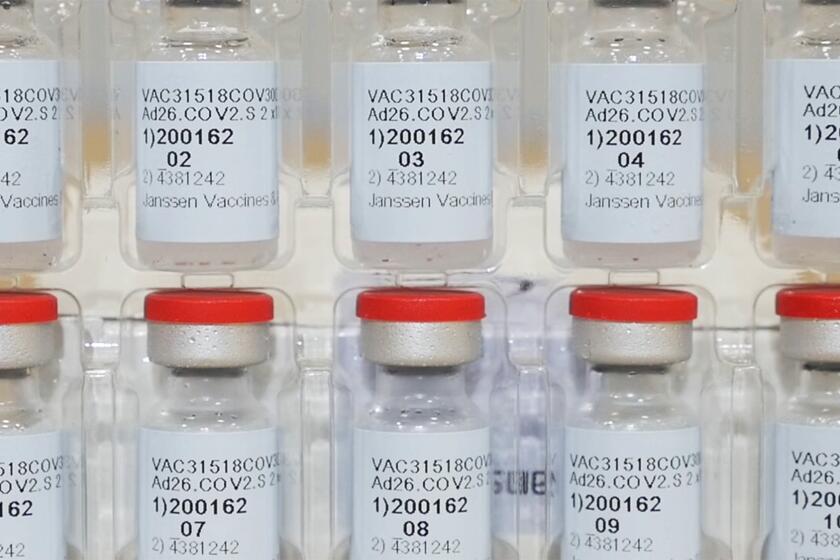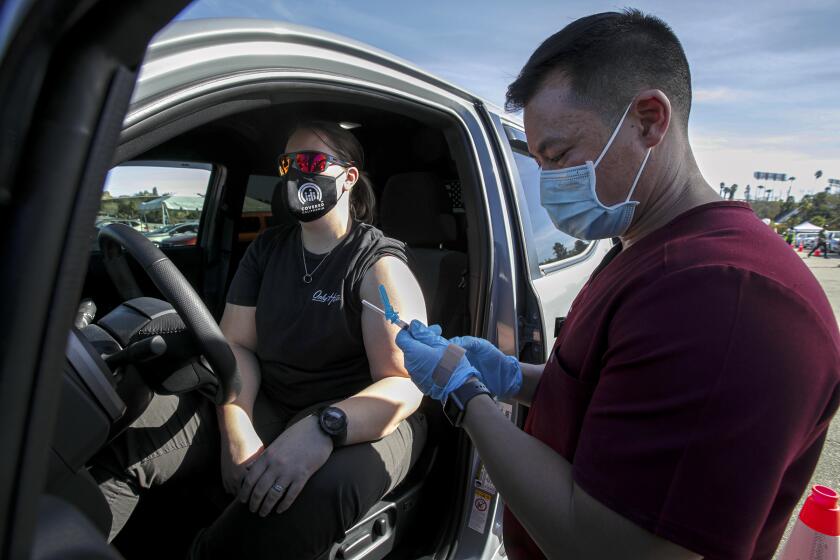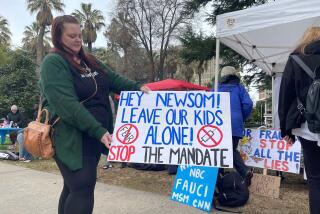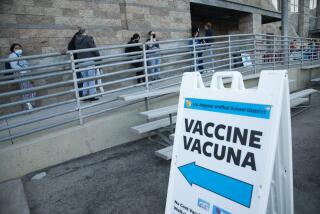California officials battle public skepticism in Johnson & Johnson COVID-19 vaccine
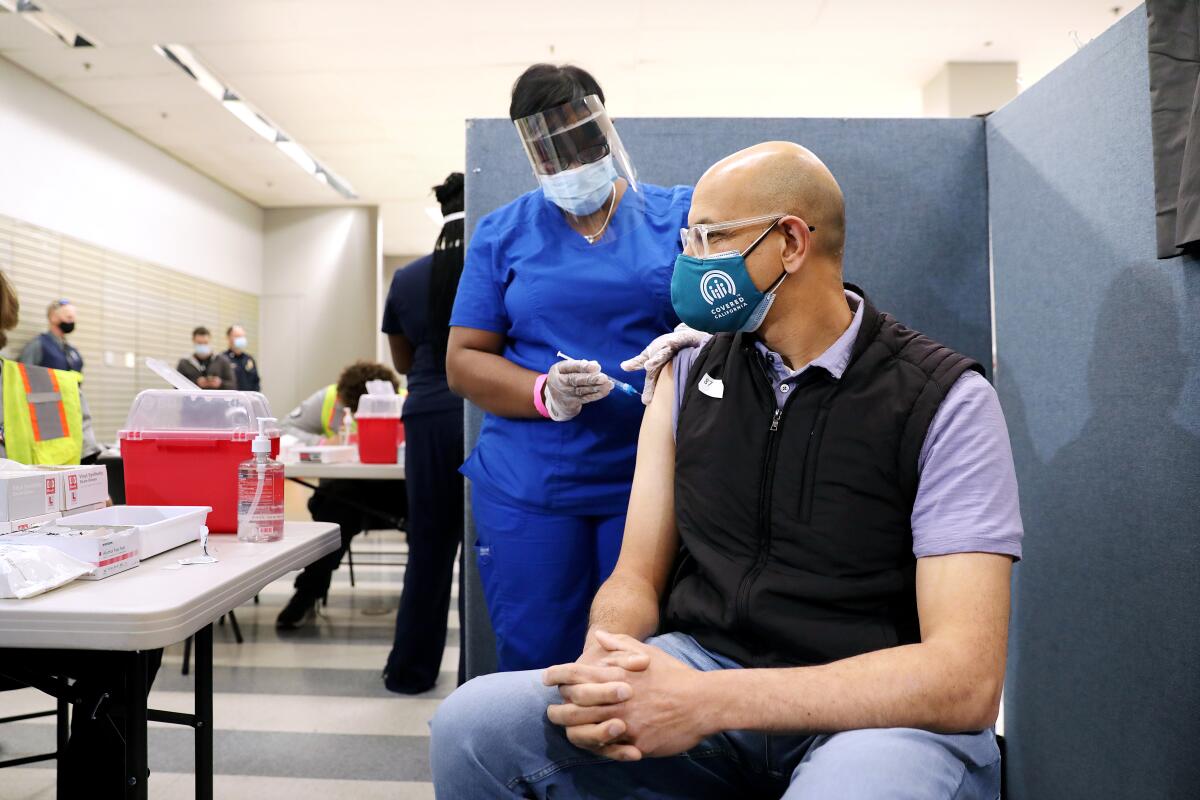
- Share via
Five of California’s top doctors in state government have received the Johnson & Johnson COVID-19 vaccine, an act taken jointly in front of news cameras as officials seek to promote the most recently authorized shot.
Federal and state scientists have been focused recently on touting the benefits of the Johnson & Johnson vaccine, a single-dose shot that has provided virtually 100% protection against the kind of life-threatening COVID-19 disease that leads to hospitalization and death.
Officials have been trying to boost public confidence in the vaccine because, at the time the clinical trials were conducted, the Johnson & Johnson shot was only 72% effective against moderate to severe infection in the U.S.
That’s an impressive percentage compared with the flu vaccine, but officials are concerned that the public will avoid taking the Johnson & Johnson shot to wait for the vaccines made by Pfizer-BioNTech and Moderna. Those shots, which require two doses, were tested earlier in the pandemic, before the wider distribution of worrisome variants, and were found to be more than 94% effective in preventing people from getting sick at all.
The COVID-19 vaccine from Johnson & Johnson will save lives. But public health officials must address the false narrative that it’s a lesser vaccine.
Officials say it’s impossible to compare which vaccines are more effective because they were tested at different points in the pandemic.
What they do know is that all three vaccines currently available in the U.S. offered extraordinary protection against hospitalizations and deaths from COVID-19 in clinical trials. Health officials are urging people to take whatever vaccine they’re offered when it’s made available to them.
What authorities do not want is for people to decline the Johnson & Johnson shot to wait for the Pfizer or Moderna shots. Such a delay would further increase the risk of a fourth wave of the pandemic and give more time for the virus to mutate and produce new variants.
“I’m excited to have had a chance to get vaccinated with the Johnson & Johnson vaccine,” Dr. Mark Ghaly, the California health and human services secretary, said Thursday at the Baldwin Hills Crenshaw Plaza mall in Los Angeles, which is hosting a vaccination clinic. “Any vaccine that you have a chance to get is the right vaccine for you.”
The Johnson & Johnson shot is “highly effective — effective at preventing the worst complications of COVID: severe disease, hospitalization, death,” Ghaly said.
At the enormous federal vaccination site at the Oakland Coliseum, four other top state doctors were given the Johnson & Johnson shot: the director of the state Department of Public Health and state health officer, Dr. Tomás Aragón; the California surgeon general, Dr. Nadine Burke-Harris; the state epidemiologist, Dr. Erica Pan; and the state’s chief of communicable disease control, Dr. James Watt.
One benefit of the latest vaccine is that studies have confirmed it is fairly effective (74%) at preventing vaccinated people from becoming asymptomatic carriers of the virus, Aragón said. There is no similar information yet available for the Pfizer or Moderna shots.
“The best vaccine is the first one that’s in your arm,” Aragón said. “We get infections down, and we’re going to be able to get back and live a normal life.”
California releases details on how millions can get COVID-19 vaccinations beginning Monday
Additionally, Dr. Anthony Fauci, President Biden’s chief medical advisor for the COVID-19 pandemic, has said the Johnson & Johnson vaccine did well against the variant of the coronavirus that was first identified in South Africa, B.1.351.
Speedy vaccinations will hasten the time when California can retire its COVID-19 closure tier system, Aragón said, and allow society to return to more of a semblance of normality. A post-pandemic normal will likely involve ongoing monitoring of circulating coronavirus variants the same way scientists monitor the changing flu virus every year.
Aragón said he suspects that an annually updated COVID-19 vaccine shot will be needed going forward.
California continues to face a shortage of vaccines, which is expected to persist through March. But in early April, the supply is expected to go up, Aragón said. The state is administering about 1.2 million doses a week, on average, but the eventual goal will be to ramp the pace up to 4 million doses a week. But, Aragón said, “for March, we need to be patient. It won’t be as fast.”
When asked why he hadn’t received the vaccine until Thursday, Aragón — who had been the health officer for San Francisco earlier in the pandemic — said he chose to delay his shot in order to allow other healthcare providers who were seeing patients to get the shot first. “People like myself stayed back and wanted them to get vaccinated first,” Aragón said.
Times staff writer Emily Baumgaertner contributed to this report.
More to Read
Sign up for Essential California
The most important California stories and recommendations in your inbox every morning.
You may occasionally receive promotional content from the Los Angeles Times.
